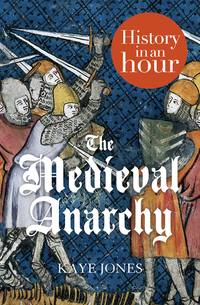
The Medieval Anarchy: History in an Hour

THE MEDIEVAL ANARCHY
History in an Hour
Kaye Jones
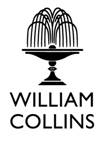
About History in an Hour
History in an Hour is a series of ebooks to help the reader learn the basic facts of a given subject area. Everything you need to know is presented in a straightforward narrative and in chronological order. No embedded links to divert your attention, nor a daunting book of 600 pages with a 35-page introduction. Just straight in, to the point, sixty minutes, done. Then, having absorbed the basics, you may feel inspired to explore further.
Give yourself sixty minutes and see what you can learn …
To find out more visit http://historyinanhour.com or follow us on Twitter: http://twitter.com/historyinanhour
Contents
Cover
Title Page
About History in an Hour
Introduction
The White Ship Disaster
The Succession Crisis
Stephen the Usurper
The Scottish Invasion
The Rise of Matilda
Civil War Begins
The Battle of Lincoln
Lady of the English
Rout of Winchester
King Stephen Fights Back
Rebellion of Geoffrey de Mandeville
Faringdon
The Next Generation
The Expedition of 1153
The Treaty of Winchester
The Legacy of the Anarchy
Appendix 1: Key Players
Appendix 2: Timeline of The Medieval Anarchy
Copyright
Got Another Hour?
About the Publisher
Introduction
The earth bare no corn, for the land was all laid waste by such deeds; and they said openly, that Christ slept, and his saints. Such things, and more than we can say, suffered we nineteen winters for our sins
The Anglo-Saxon Chronicle
The death of King Henry I in 1135 created a succession crisis that resulted in England’s first civil war. Nicknamed ‘The Anarchy’ for its unprecedented levels of chaos and disorder, this nineteen-year conflict witnessed the usurpation of King Stephen, and a persistent battle on the part of Henry’s daughter, Matilda, to reclaim her royal inheritance. Though the civil war came to a peaceful end with the Treaty of Winchester in 1153, it was Matilda’s son, Henry, who succeeded to the throne of England after the death of King Stephen in 1154.
This, in an hour, is the story of The Medieval Anarchy through the personalities, context, events, and aftermath of England’s first, and often forgotten, civil war.
The White Ship Disaster
No ship ever brought so much misery to England
William of Malmesbury
As Duke of Normandy, King Henry I made frequent trips to his Duchy across the Channel. In November 1120, Henry was accompanied by his son and heir, William Adelin. On arrival in the French port of Barfleur, Thomas FitzStephen, master of the White Ship, approached the King and offered his services. FitzStephen claimed that his father had been employed by William the Conqueror as his personal captain; he had taken the Duke to England for the invasion of 1066. As Henry already had a good ship and crew of his own, he suggested that his son, William, and his party use the White Ship instead.
Having spent much of the day drinking, the 300-strong group – including FitzStephen, the helmsman and fifty oarsmen – were roaring drunk by the time they boarded the ship on the evening of 25 November 1120. Desperate to overtake the King’s ship, which had already cleared the harbour, the helmsman began to steer the vessel northwards. It was during this manoeuvre that the White Ship hit a rock on its port side and began to fill with water. In a bid to save the King’s heir, Prince William and a small group of oarsmen descended into a dinghy and began to sail away from the ship. But the cries of those left behind soon became too much for William to bear and he ordered that the dinghy be turned around to help those in need. His attempts were in vain; the White Ship soon capsized, dragging William and his party deep into the murky waters.
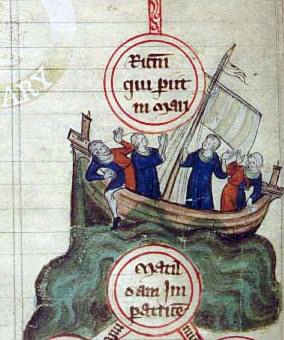
White Ship Disaster
With only one known survivor, it is difficult to ascertain the full details of that fateful night. The lucky survivor was a butcher from Rouen, saved by the warm ram-skins that he was wearing and rescued by three fishermen the next day. The White Ship disaster claimed the lives of William Adelin and two of Henry’s illegitimate children. Henry holds the record for the highest number of illegitimate children born to an English king. Historians estimate that he had approximately sixteen illegitimate daughters and nine illegitimate sons from a variety of mistresses.
Although FitzStephen, the ship’s captain, managed to swim to the surface, he allowed himself to drown rather than tell the King of William’s death. This grim responsibility was left to an unidentified young boy. On hearing the news, Henry broke down and fell to the floor. Widowed and in his early fifties, it seemed unlikely that Henry would ever produce another male heir. His son’s death had had truly set England on the road to disaster.
The Succession Crisis
In the aftermath of William’s death, Henry’s attention naturally turned to the issue of the succession. In a last ditch attempt to procure a legitimate male heir, a second marriage was suggested to Adeliza of Louvain. Young and attractive, it was hoped that she would quickly conceive a son. The marriage took place at Windsor Castle on 29 January 1121, with Adeliza’s coronation carried out the following day.
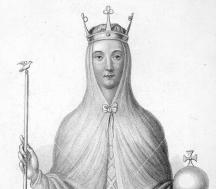
Queen Adeliza
In the meantime Henry looked to his immediate family for a possible heir to his throne, should his plans for a son by Adeliza fail. Although he had other children, their illegitimacy ruled them out as potential candidates, though he had a particular fondness for the eldest, Robert, Earl of Gloucester. He had nephews too to consider. Stephen of Blois, for instance. After all, Stephen had been living in his household for several years and had already demonstrated impressive military and political skills on a previous trip to Normandy.
But William Adelin was not Henry’s only legitimate child. So far unconsidered, Matilda, now Empress of the Holy Roman Empire, was Henry’s first-born and had the strongest claim among his family. Henry had not seen Matilda since 1110 when she had left England to marry Henry V, the Holy Roman Emperor. The marriage was childless and Matilda, widowed in 1125, was left with a rather uncertain future. Now, in 1126, Henry wondered if she might provide a solution to the succession problem. He called on his daughter to join him in Normandy, no doubt to get better acquainted, and, quite possibly, to discuss the realm’s future.

Henry V and the Empress Matilda
Henry also took some time to discuss Matilda’s suitability with his leading barons and advisers. In general they were uneasy about Matilda succeeding her father. After all, there was no precedent of female governance in England. In an era where the role of monarch encompassed politician and soldier, the unsuitability of women for such a position was a sentiment echoed by many. King David of Scotland, the brother of Henry’s late wife, and Robert, Earl of Gloucester, however, both spoke out in favour of Matilda and it was to these men that Henry listened. Thus, in January 1127, Henry named Matilda as his heir and invited the leading clergymen and barons of the realm to swear an oath of fealty to her, supporting her succession to the throne of England and the Duchy of Normandy.
In the meantime Henry arranged a second marriage for Matilda. The chosen groom was Geoffrey, a fourteen-year-old, who would become the Count of Anjou on his father’s death in 1129. The pair were married on 17 June 1128, in the French town of Le Mans. Shortly after the wedding, Henry once again called on his barons to swear an oath of fealty to Matilda, suggesting that he may have doubted their faithfulness. As Matilda had just married into the House of Anjou, the historic enemy of the Normans, the barons disliked the idea that Geoffrey might rule them in one capacity or another after Henry’s death. But, in 1131, Henry acted to make it clear that Matilda was his heir. For a third time, he called on his barons and clergy to swear an oath of fealty to his daughter.
The marriage between Matilda and Geoffrey turned sour soon after the wedding, but Henry was able to reconcile the couple and was soon rewarded with the arrival of grandsons. The first, Henry, was born on 5 March 1133, while the second, Geoffrey, appeared on 1 June 1134. In between the births, Henry had embarked on his final voyage across the Channel to Normandy. While on a hunting trip in November 1135, he fell ill after eating lampreys, his favourite food. An eel-like fish, lampreys were a popular delicacy in the Middle Ages, though Henry had been advised by his physician never to eat them. Surrounded by friends and family, including his illegitimate son, Robert, Earl of Gloucester, Henry made his last confession and received the last rites. If William of Malmesbury is to be believed, Henry also asked those present to accept Matilda as heir to England and Normandy. He then passed away on 1 December 1135.
Stephen the Usurper
Matilda was in Anjou at the time of her father’s death. Father and daughter had recently argued over the ownership of several castles that were allegedly promised by Henry to the couple after their wedding. For reasons unknown, Matilda did not act to secure her inheritance when she heard of her father’s passing. However, Stephen of Blois, Henry’s nephew, took the initiative and despite warnings of a severe storm, set sail immediately from Blois to march on London. Popular among the citizens, they welcomed Stephen and he rewarded them with commune status, a privilege granting greater control over the city’s affairs. In return, they swore an oath of fealty and elected him as their chosen king.
With the support of the people secured, Stephen headed to Winchester. Here, and possibly with the help of his brother, Henry, Bishop of Winchester, Stephen gained the support of Roger, Bishop of Salisbury, and William Pont de l’Arche, the royal treasurer. Stephen encountered some difficulty in persuading William Corbeil, Archbishop of Canterbury, to perform the coronation ceremony. Probably mindful of his oath to Matilda, it was only when Stephen made promises to uphold and protect the Church that he was convinced otherwise. After all, the country needed a ruler and Matilda was nowhere to be seen.
On 22 December 1135, Stephen of Blois was crowned in a ceremony at Winchester where he was anointed with holy oil and swore to uphold all the ‘liberties and good laws’ enacted by his predecessors. When news of the coronation reached Normandy, the local barons immediately accepted Stephen as their new duke.
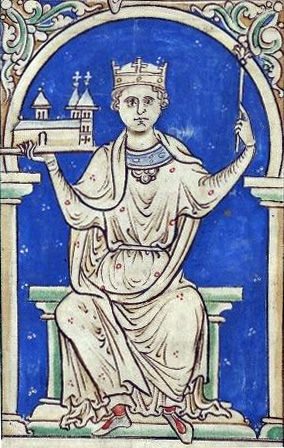
King Stephen
As in Normandy, the majority of English barons were happy to have Stephen as their new ruler. He was popular, well-liked, and regarded as an efficient and capable man. A few men still remained who intended to honour their oath to Matilda, and so Stephen set about winning them over. One of the most resistant was Robert, Earl of Gloucester; he took until Easter to pay homage to the new king. Finally, just one leading figure remained who was not yet persuaded.
The Scottish Invasion
Back in 1127, it was King David of Scotland who had first sworn fealty to Matilda. We can never be sure if it was a simple case of putting family first (Matilda was David’s niece), or whether he genuinely felt her to be a capable ruler. Either way, he did not take the news of Stephen of Blois’ accession well; he refused to pay him homage and instead gathered his army and invaded the north of England. He captured the most strategically important towns of the border counties, including Carlisle, Alnwick, and Newcastle-upon-Tyne. Wherever he went, he took hostages and made men swear to uphold Matilda’s claim to the throne. It was in the New Year that Stephen heard of David’s campaign and by the time he had marched his army north, David was preparing to attack Durham.
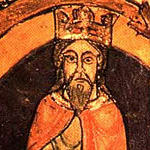
King David I of Scotland
Fortunately the two kings began negotiating terms of peace before the attack on Durham got underway. Under the terms of this agreement, known as the First Treaty of Durham, made on 5 February 1136, David retained Cumbria but surrendered Northumbria and Newcastle-upon-Tyne. David’s son, Henry, was granted Doncaster, the lordship of Carlisle and the earldom of Huntingdon in return for paying homage to Stephen. Though David still refused to accept Stephen as king, the treaty marked a swift and successful end to hostilities.
Stephen’s next challenge surfaced much closer to home when Baldwin de Redvers, Earl of Devon, seized the royal castle at Exeter, prompting its citizens to request immediate help of Stephen. During his siege of the castle, in the summer of 1136, Baldwin secretly escaped to Carisbrooke. After three months, the Exeter garrison handed back the castle to Stephen, restoring peace and royal authority to the city. Having run out of water at Carisbrooke, however, Baldwin appealed to the king for mercy but was instead stripped of his lands and exiled. Baldwin fled to Anjou where he would later become one of Matilda’s most active supporters.
While Matilda had made no direct attack on Stephen’s kingship in England, she was now actively asserting her rights in Normandy. Possibly the news of Stephen’s usurpation was enough to motivate such action. She began by occupying the castles of Exemes, Domfront, and Argentan, of which the latter served as a more permanent base and provided the setting for the birth of her third son, William, on 22 July 1136. In October she travelled to Le Sap where her husband, Geoffrey, was busy laying siege to the town’s castle. Though his attack was unsuccessful, he was undeterred and continued his assault on Normandy for the next three years. Back in England, Stephen could hardly ignore the developing chaos in his Duchy and he crossed the Channel in March 1137. He hoped to reoccupy Argentan but instead agreed a truce with Geoffrey: the King would pay him 2,000 marks a year in return for peace along the Normandy–Anjou border. Geoffrey agreed and Stephen returned to England in December.
During Stephen’s absence from England, however, King David had launched a second invasion in a bid to extend his territories. Shortly after Easter in 1137, he marched on Northumberland with his army and began pillaging the area. Fortunately Stephen’s earls and barons were able to repel the Scots and force David to accept a six-month truce. But after six months, the truce had expired and Stephen was forced to return from Normandy to face King David who was once again knocking on England’s door.
Battle of the Standard
[King David] hastened with his whole force to devastate Northumberland. And then that execrable army, more atrocious than the whole race of pagans, neither fearing God nor regarding man, spread desolation over the whole province, and murdered everywhere persons of both sexes, of every age and rank, and devastated towns, churches and houses.
Richard of Hexham
Like his previous campaigns, David’s third invasion of England in 1138 was not just an attempt to extend his sovereignty, it was also an opportunity to promote and assert Matilda’s claim to the throne. However, the brutality of the Scottish army only served to harden attitudes against King David and strengthen the local population’s loyalty to Stephen. David experienced an early success at the Battle of Clitheroe on 10 June 1138 where a section of his army, commanded by William Fitz Duncan, defeated the English in the northern county of Lancashire.
With the Scots now wreaking havoc across the north, the English had no choice but to attack. On 22 August 1138 the two armies met at Cowton Moor, near Northallerton, in Yorkshire. The ensuing conflict is known as the Battle of the Standard, a name that derives from the religious banners carried into battle by the English. In an assault that lasted less than a few hours, the Scots had either fled the battlefield or been destroyed by showers of English arrows and deadly hand-to-hand combat. When he heard news of the great victory, King Stephen was said to be overjoyed.
The battle may have been won but Stephen needed to prevent a repeat performance. In particular, he needed a settlement that would placate David’s territorial ambitions. Under the terms of this peace agreement, known as the Second Treaty of Durham, Henry, David’s son, was granted the earldom of Northumberland. A marriage to Ada, daughter of the Earl of Surrey, was also arranged and the pair wed the following year. While these generous concessions ended one war, there was another one brewing back in England.
The Rise of Matilda
A major turning point in King Stephen’s reign was marked by the defection of Robert, Earl of Gloucester, to Matilda’s side in May 1138. From this point on the country descended rapidly into anarchy, chaos, and civil war. Whether he was stirred by familial affection for his half-sister or suffered an attack of conscience after breaking his many oaths, we will never know. More important than the reasons, however, are the consequences of this act.
The conflict began with a series of major rebellions that broke out in southwest England, possibly inspired by Robert’s defection. Stephen acted swiftly to crush the revolts and laid successful sieges at Hereford, Shrewsbury, Castle Cary, and Harptree but was unable to take Robert’s stronghold of Bristol. The Welsh Marches, including Dudley and Ludlow, along with Dover, another of Robert’s castles, also revolted against Stephen but were quickly brought back under royal control.
Though these rebellions were relatively small, they demonstrate the extent of Robert’s influence. As the chronicle, Gesta Stephani, states:
[the rebels] were bound to the earl [Robert] by ties of friendship, firmly united with him by pledge and oath, and so much his allies by compact and homage that as soon as they learned he wished to rebel against the king’s power, they joined in his rebellion promptly and by agreement.
The defection of one man had brought Matilda the strength and might of the southwest of England.
Second Lateran Council
In early 1139, Matilda launched her first direct attack on Stephen by writing to the Papal court in Rome. As the highest authority in Medieval Europe, Matilda knew that securing this support for her claim was crucial to becoming queen of England. The Papal court agreed to hear the case and discussions opened on 4 April 1139 at a meeting known as the Second Lateran Council. Neither Matilda nor Stephen attended in person but each sent representatives to appear on their behalf.
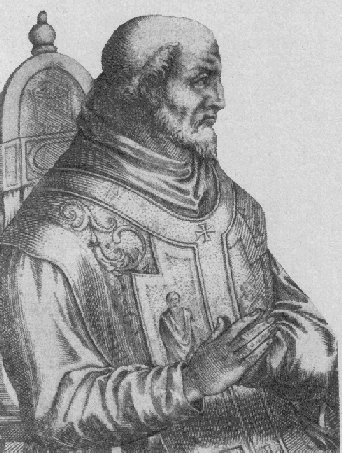
Pope Innocent II, convened the Second Lateran Council
The Pope, with whom all decisions lay, neither adjourned nor passed judgement on the case. This created a situation whereby Stephen continued to rule and Matilda was left anxious and frustrated. In fact the Pope never made a formal decision on the English succession. Perhaps he hoped that Stephen and Matilda might come to some agreement on their own. The Pope’s indecision only strengthened Matilda’s resolve to reclaim her inheritance by force, and with the support of Robert, the decision was made to take the fight directly to Stephen in England.
Конец ознакомительного фрагмента.
Текст предоставлен ООО «ЛитРес».
Прочитайте эту книгу целиком, купив полную легальную версию на ЛитРес.
Безопасно оплатить книгу можно банковской картой Visa, MasterCard, Maestro, со счета мобильного телефона, с платежного терминала, в салоне МТС или Связной, через PayPal, WebMoney, Яндекс.Деньги, QIWI Кошелек, бонусными картами или другим удобным Вам способом.
Вы ознакомились с фрагментом книги.
Для бесплатного чтения открыта только часть текста.
Приобретайте полный текст книги у нашего партнера:
Всего 10 форматов

